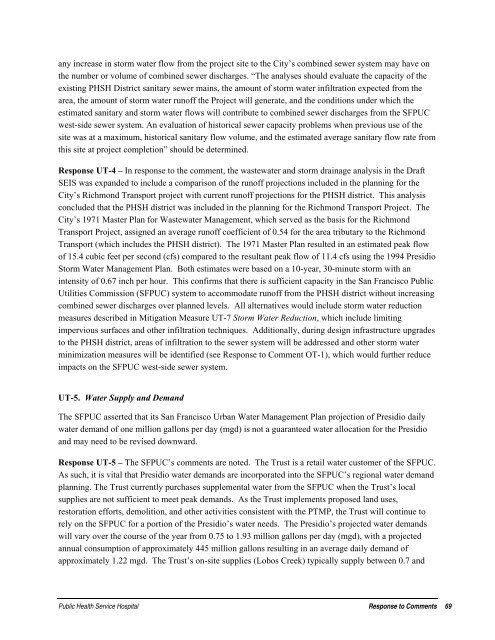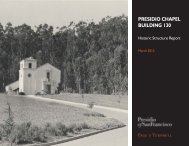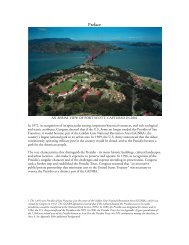Response to Comments - Presidio Trust
Response to Comments - Presidio Trust
Response to Comments - Presidio Trust
You also want an ePaper? Increase the reach of your titles
YUMPU automatically turns print PDFs into web optimized ePapers that Google loves.
any increase in s<strong>to</strong>rm water flow from the project site <strong>to</strong> the City’s combined sewer system may have onthe number or volume of combined sewer discharges. “The analyses should evaluate the capacity of theexisting PHSH District sanitary sewer mains, the amount of s<strong>to</strong>rm water infiltration expected from thearea, the amount of s<strong>to</strong>rm water runoff the Project will generate, and the conditions under which theestimated sanitary and s<strong>to</strong>rm water flows will contribute <strong>to</strong> combined sewer discharges from the SFPUCwest-side sewer system. An evaluation of his<strong>to</strong>rical sewer capacity problems when previous use of thesite was at a maximum, his<strong>to</strong>rical sanitary flow volume, and the estimated average sanitary flow rate fromthis site at project completion” should be determined.<strong>Response</strong> UT-4 – In response <strong>to</strong> the comment, the wastewater and s<strong>to</strong>rm drainage analysis in the DraftSEIS was expanded <strong>to</strong> include a comparison of the runoff projections included in the planning for theCity’s Richmond Transport project with current runoff projections for the PHSH district. This analysisconcluded that the PHSH district was included in the planning for the Richmond Transport Project. TheCity’s 1971 Master Plan for Wastewater Management, which served as the basis for the RichmondTransport Project, assigned an average runoff coefficient of 0.54 for the area tributary <strong>to</strong> the RichmondTransport (which includes the PHSH district). The 1971 Master Plan resulted in an estimated peak flowof 15.4 cubic feet per second (cfs) compared <strong>to</strong> the resultant peak flow of 11.4 cfs using the 1994 <strong>Presidio</strong>S<strong>to</strong>rm Water Management Plan. Both estimates were based on a 10-year, 30-minute s<strong>to</strong>rm with anintensity of 0.67 inch per hour. This confirms that there is sufficient capacity in the San Francisco PublicUtilities Commission (SFPUC) system <strong>to</strong> accommodate runoff from the PHSH district without increasingcombined sewer discharges over planned levels. All alternatives would include s<strong>to</strong>rm water reductionmeasures described in Mitigation Measure UT-7 S<strong>to</strong>rm Water Reduction, which include limitingimpervious surfaces and other infiltration techniques. Additionally, during design infrastructure upgrades<strong>to</strong> the PHSH district, areas of infiltration <strong>to</strong> the sewer system will be addressed and other s<strong>to</strong>rm waterminimization measures will be identified (see <strong>Response</strong> <strong>to</strong> Comment OT-1), which would further reduceimpacts on the SFPUC west-side sewer system.UT-5. Water Supply and DemandThe SFPUC asserted that its San Francisco Urban Water Management Plan projection of <strong>Presidio</strong> dailywater demand of one million gallons per day (mgd) is not a guaranteed water allocation for the <strong>Presidio</strong>and may need <strong>to</strong> be revised downward.<strong>Response</strong> UT-5 – The SFPUC’s comments are noted. The <strong>Trust</strong> is a retail water cus<strong>to</strong>mer of the SFPUC.As such, it is vital that <strong>Presidio</strong> water demands are incorporated in<strong>to</strong> the SFPUC’s regional water demandplanning. The <strong>Trust</strong> currently purchases supplemental water from the SFPUC when the <strong>Trust</strong>’s localsupplies are not sufficient <strong>to</strong> meet peak demands. As the <strong>Trust</strong> implements proposed land uses,res<strong>to</strong>ration efforts, demolition, and other activities consistent with the PTMP, the <strong>Trust</strong> will continue <strong>to</strong>rely on the SFPUC for a portion of the <strong>Presidio</strong>’s water needs. The <strong>Presidio</strong>’s projected water demandswill vary over the course of the year from 0.75 <strong>to</strong> 1.93 million gallons per day (mgd), with a projectedannual consumption of approximately 445 million gallons resulting in an average daily demand ofapproximately 1.22 mgd. The <strong>Trust</strong>’s on-site supplies (Lobos Creek) typically supply between 0.7 andPublic Health Service Hospital <strong>Response</strong> <strong>to</strong> <strong>Comments</strong> 69















